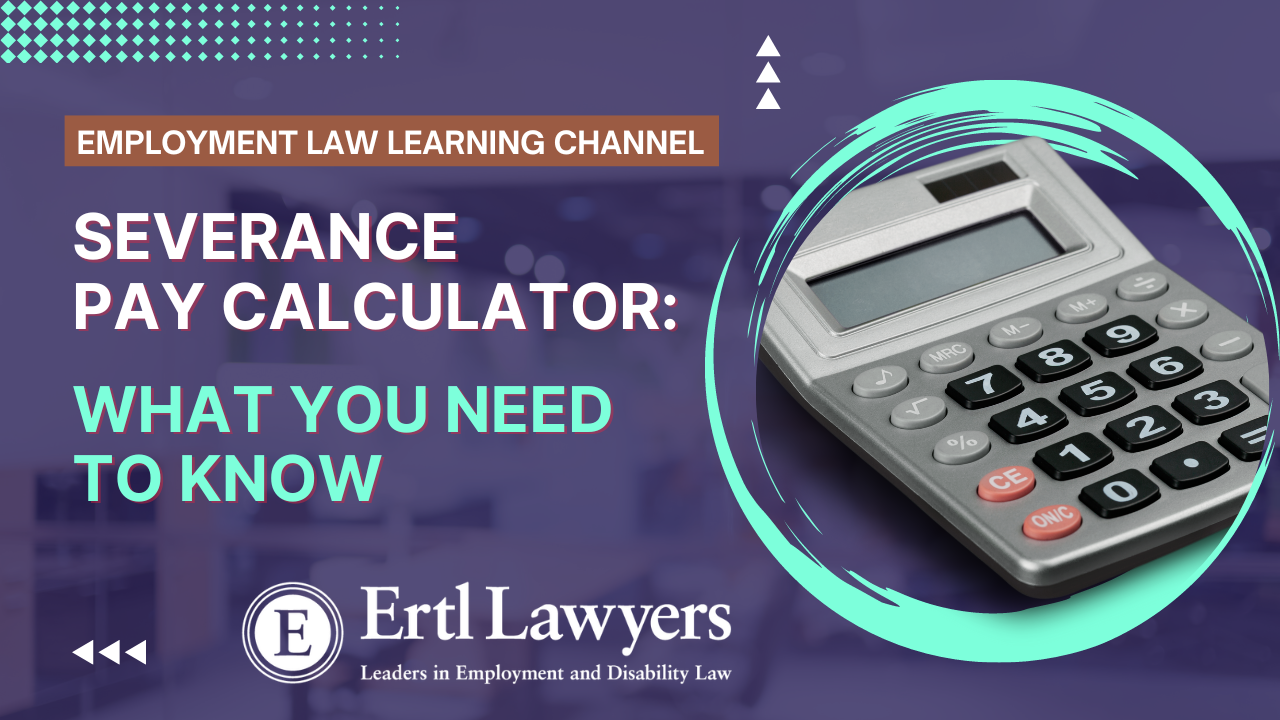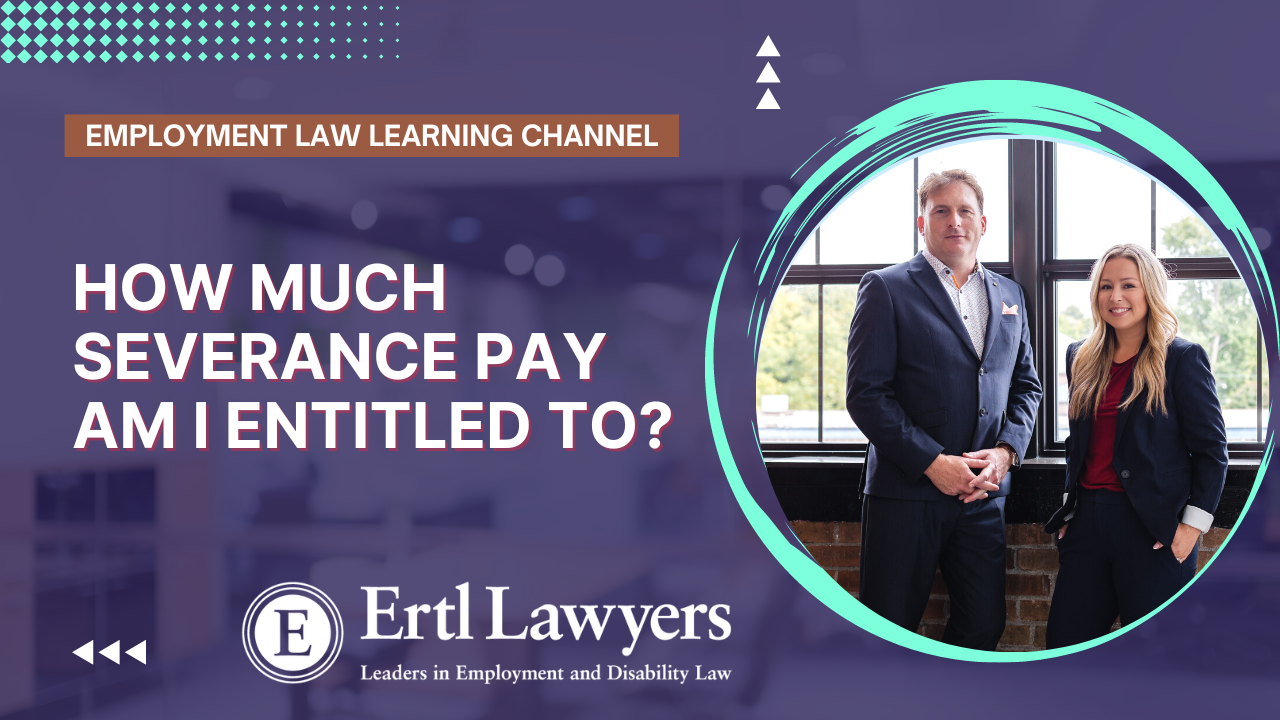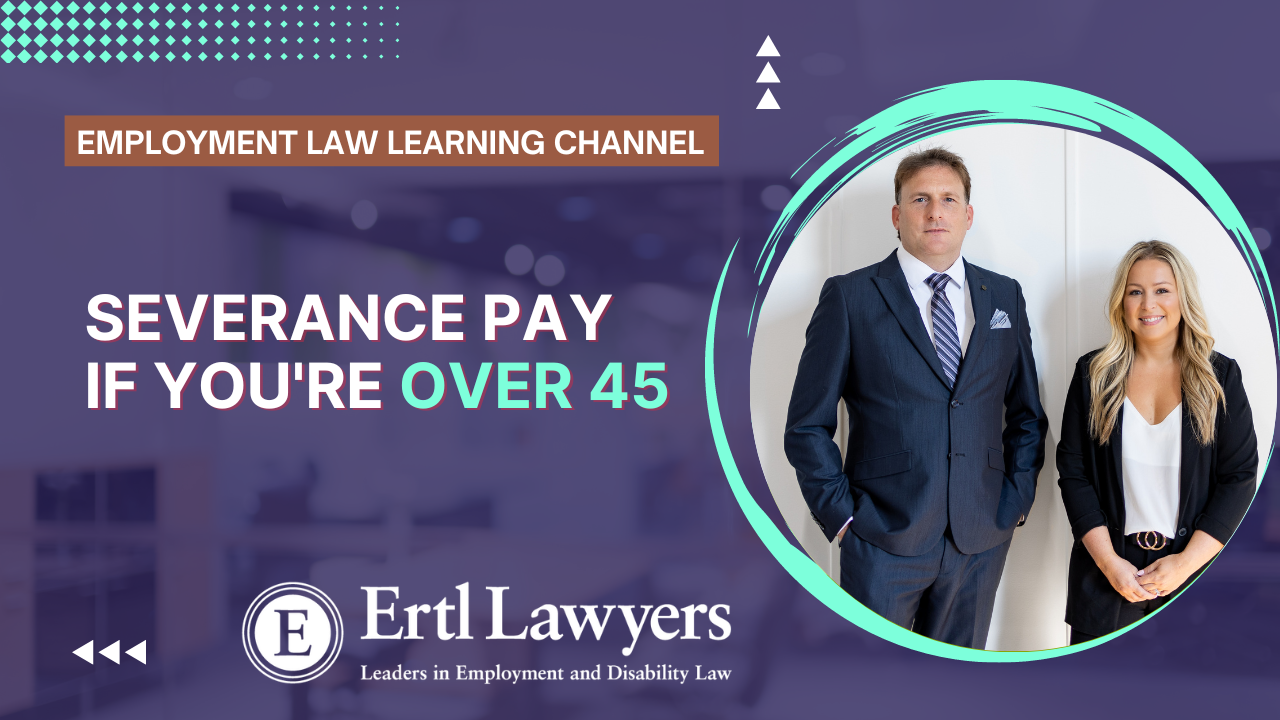Constructive Dismissal

The meaning of constructive dismissal
In this article, we will discuss what constructive dismissal is, how to identify it, and the most common examples of constructive dismissal, and we’ll discuss possible options if you have been constructively dismissed.
We will also answer questions about compensation for constructive dismissal, how long your case might take, how it affects employment insurance, the potential dangers of going to the Ministry of Labour, and whether you should consult an experienced employment lawyer.
After reading this article, Ertl Lawyers offers a free consultation if you’d like to discuss your employment matter. No strings attached. No obligation.
We also offer fair and flexible billing options, like contingency fees (don’t pay unless you win).
When does constructive dismissal occur?
Constructive dismissal happens when your employer fundamentally changes your employment without your consent. However, it can also happen when the employer behaves in a way that is incompatible with the employment relationship.
A constructive dismissal is a termination of your employment, caused by the employer.
We’ll discuss the two types of constructive dismissal below.
A fundamental change to your employment
A constructive dismissal occurs if your employer has changed a term of your employment contract without your consent, and the change is substantial enough to be considered a fundamental breach of your contract.
First, the change must happen without your consent (a “unilateral” change). On the other hand, consent is provided if:
- your employment agreement expressly permits the change
- you agree to the change when it’s made
- if you wait too long to reject the change (If you wait too long, then the law says you have accepted or acquiesced to the change)
Second, the change must be substantial. It cannot be a change of some minor rights or of a non-vital term of the contract of employment). A demotion or a reduction of compensation are examples of substantial changes.
Employer behaviour or conduct that is incompatible with your employment relationship
A constructive dismissal also happens when the employer acts in a way that demonstrates it no longer intends to be bound by the employment contract. With this type of constructive dismissal, the employer doesn’t need to breach an express term of your contract. Rather, the behaviour or conduct can be a single act or a series of acts.
Here, the focus is on whether the employer’s conduct makes continued employment intolerable for the employee. Some examples of this type of constructive dismissal include abusive or harassing treatment, bullying, and unsafe working conditions.
Most common examples of constructive dismissal
Demotion
A demotion is a common constructive dismissal example. However, it’s all about context.
Demotions are more likely to be considered a constructive dismissal if they result in:
- loss of prestige and status:McKilligan v. Pacific Vocational Institute, 1981 CanLII 442 (BC CA)
- loss of perceived and actual leadership:Jodoin v. Nissan Canada Inc., 2013 ONSC 4683 (CanLII)
- a loss of future advancement:Reber v. Lloyds Bank International Canada, 1985 CanLII 153 (BC CA)
A demotion is less likely to be a constructive dismissal:
- When the demotion is a minor one:Longman v. Federal Business Development Bank, 1982 CanLII 543 (BC SC).
- Where the change is a “lateral” move:Winsor v. Canada Trust Co., 1993 CanLII 7754 (NL CA).
- When it does not result in an apparent loss of prestige
When the employer is acting upon genuine economic necessity
Examples of demotions that were found (by the courts) to be constructive dismissals:
- Executive demoted to branch manager
- Demotion from general sales manager to salesman, with a decrease in the sphere of activity and responsibility
- Chef demoted to sous-chef
- Employee demoted to position he held earlier in career
- Organization change resulting in department head becoming second in command
Examples of demotions that were found (by the courts) NOT to be constructive dismissals:
- Employee is given additional duties (from a different but related position)
- Change of job title to lower position but no loss of prestige because the proposed project he was to work on meant greater importance to the organization, and the change of position was because of the economic necessity of the employer
- Temporary assignment to a new position
Reduction in compensation
A reduction in your overall compensation is probably the most common constructive dismissal example; however, not all reductions are equal.
A reduction in your overall compensation of more than 5% to 10% is usually a constructive dismissal.
Minor changes in compensation will not be regarded as a fundamental breach of the employment contract.
To be clear, the law is concerned with your overall compensation. For example, even a 50% reduction to your bonus won’t trigger a constructive dismissal if the change to your overall compensation is not more than 5% to 10%.
But, even a slight reduction to your compensation, when combined with other significant changes to your employment, can be a constructive dismissal.
Reductions that can be constructive dismissals include:
- Reducing your fixed salary
- Reducing your commissions (this includes a change in the commission formula that is likely to lead to lower commissions)
- Reducing your bonus (this includes a change to the bonus formula that is likely to lead to a lower bonus)
- Reducing/eliminating your benefits
- Reducing/eliminating perks like car allowance, payment of travel time, etc.
Temporary layoff
A temporary layoff is generally considered a constructive dismissal unless one (or more) of the following is present:
- the employment contract expressly permits a layoff (meaning there is an actual, valid clause in the contract that gives the employer the right to layoff the employee)
- layoffs are a well-known industry-wide practice
- the employee has been laid off before
- the employee consents to the layoff
Reduction in hours
A reduction in work hours is usually a constructive dismissal and is closely related to a “reduction in compensation.”
In one case, reducing hours from 40 to 29 per week was considered a constructive dismissal.
In another case, moving someone from a full-time to a part-time position was also a constructive dismissal.
Change in responsibilities
A unilateral change to the responsibilities and duties of an employee can be a constructive dismissal. However, the analysis is a highly contextual one.
The question is: in all the circumstances, is the change so substantial?
Employees are not entitled to have their responsibilities and duties fixed in stone. An employer should have some latitude, especially concerning lateral or upward changes to an employee’s job.
Change in location
A change in the employment location (i.e., a geographic transfer) is another good constructive dismissal example.
However, the courts need to be more consistent on this issue.
Some courts have found that employees are not entitled to a job for life in a place of their choosing. Other courts have found no presumption that employers can unilaterally move their employees around.
That said, courts tend to take the position that, with some exceptions, the location of work is a fundamental term of the employment contract.
Harassment or abusive treatment
An implied term of any employment relationship is that the employer will treat the employee with civility, decency, honesty, and respect. Therefore, any employer that engages in – or condones – conduct that makes continued employment impossible or intolerable will likely be liable for constructive dismissal.
Other potential constructive dismissal examples include:
Breach of employee’s privacy
Sale of the Employer’s business
Increase in Working Hours
Change in Reporting Relationships
Removal of Support and Infrastructure
Negative Performance Reviews
Performance Improvement Plans
Unwarranted Discipline
What are my options if I have been constructively dismissed?
If you believe that you have been constructively dismissed, what can you do about it? Can you fight it? Can you raise the issue of constructive dismissal without resigning? What are your options?
Your options depend on your particular set of circumstances, but in general, someone who has been constructively dismissed faces several options, including:
1. Accept the change.
2. Advise the employer that they are willing to “try out” the change without giving up their right to claim constructive dismissal. How long can the employee “try out” the change for? A reasonable period. That period is probably longer for longer-serving employees.
3. Reject the change and ask the employer not to implement it or “undo” the change (if it has already been made).
4. Claim constructive dismissal and continue to work for the employer only to “mitigate” their damages.
5. Claim constructive dismissal, do not return to work, and seek compensation.
Caution: You should always consult an experienced employment lawyer before considering taking any steps.
Every option has consequences; your lawyer can advise you on the most appropriate strategy.
How to prove constructive dismissal
A constructive dismissal may be apparent. For example, your employer might tell you that your salary is being reduced effective immediately.
Sometimes, it’s not that obvious. For example, your employer rolls out a new commission plan that might result in lower compensation. In that case, proving a constructive dismissal might entail waiting to see whether the commission’s plan did reduce your compensation, or you might be able to prove it right away if you can do so without purely speculating.
Caution: this is a complex area of the law. Before taking any steps, you should consult with an experienced employment lawyer.
How to claim constructive dismissal
A claim of constructive dismissal is usually made in court.
Negotiation or mediation resolves most matters without filing a court claim.
Even if a court claim is filed, the matter is usually resolved without ever having to attend court.
Only about 1 or 2 per cent of constructive dismissal claims (considered “wrongful dismissal” claims) ever go to a trial.
Compensation for constructive dismissal
A constructive dismissal claim is simply a type of wrongful dismissal claim. Something the employer did has caused the employment agreement to be breached/terminated, and if the employer doesn’t provide proper severance, it is considered “wrongful”.
So, the compensation for constructive dismissal is no different than if the employer terminated you without cause for lack of work downsizing or redundancy.
The whole point is to provide you with proper severance – long enough to find comparable employment.
Try our severance pay calculator to see what you might be entitled to.
How long does a constructive dismissal case take?
Generally speaking, we can resolve constructive dismissal cases without having to file a claim. We can typically negotiate a severance package for our clients based on negotiations alone. The matter should be resolved within a few weeks. Commencing a claim will, of course, increase the amount of time. If a claim is filed, it will likely settle following further negotiations or mediation. Commonly, that will be within a few months. Some matters take longer.
Constructive dismissal and employment insurance
Usually, if you quit your job, you are not entitled to employment insurance benefits.
However, under Ontario’s Employment Insurance Act, there are certain circumstances where an employee may voluntarily leave their employment without forfeiting their E.I. Those circumstances or reasons include:
- sexual or other harassment,
- obligation to accompany a spouse, common-law partner or dependent child to another residence,
- discrimination on a prohibited ground of discrimination within the meaning of the Canadian Human Rights Act,
- working conditions that constitute a danger to health or safety,
- obligation to care for a child or a member of the immediate family,
- reasonable assurance of another employment in the immediate future,
- significant modification of terms and conditions respecting wages or salary,
- excessive overtime work or refusal to pay for overtime work,
- significant changes in work duties,
- antagonism with a supervisor if the claimant is not primarily responsible for the antagonism,
- practices of an employer that are contrary to law,
- discrimination with regard to employment because of membership in an association, organisation or union of workers,
- undue pressure by an employer on the claimant to leave their employment and
- any other reasonable circumstances that are prescribed.
Do I need a constructive dismissal lawyer?
Constructive dismissal is one of the more complicated areas of employment law. It is full of landmines. Even the most minor actions have consequences. So, in our view, you should always consult an experienced constructive dismissal employment lawyer to know your options.
Should I make a complaint to the Ministry of Labour?
The Ministry of Labour is responsible for administrating and enforcing legislation. This means that if you are claiming constructive dismissal to get ONLY your statutory termination pay and severance pay (which usually isn’t very much), you can complain to the Ministry of Labour.
Major Caution: The Ministry of Labour cannot help you with “common law” severance pay (which, in almost every case, is greater than statutory pay). If you make a complaint to the Ministry of Labour with respect to statutory termination pay and severance pay, you LOSE THE RIGHT to make a legal complaint for (what is likely) far more common law severance pay. We urge you to consult an experienced employment lawyer to understand your rights in every scenario.
My employer closed one of its operations and ordered me to report to another location that was 1.5 hours away (one way). I could not have survived the commute. It was a constructive dismissal, and Ertl Lawyers negotiated a severance package to help me while I looked for a new job. Very happy with the result.
– V.C., PRINTING INDUSTRY, VAUGHAN
Have You Been Constructively Dismissed?
At Ertl Lawyers, when we take on a constructive dismissal case, our strategy often results in a favourable resolution of the matter based on the employee’s departure. Some of the things we can do include: helping you behind the scenes by providing you advice, writing a letter for you called a “ghost letter”, commencing negotiations with your employer directly, and (where necessary) commencing a legal claim on your behalf and driving it to a successful resolution.
Our help can make all the difference.
Related Blogs
What To Know About the Employment Equity Act in Canada
If you want a summary of the intent behind Canada's Employment Equity Act (EEA), you need not look any further than section 2 of the EEA, the "Purpose of Act" (last updated in 2017): "The purpose of this Act is to achieve equality in the workplace so that no person...
Performance Improvement Plans in the Banking Industry
At face value, performance improvement plans (PIPs) are meant to be a tool that helps struggling employees meet specific performance-related goals. In the banking and finance industry, this commonly means meeting targets and sales quotas of various financial products....
Working Notice in Ontario
Suppose an employer wants to end an employment contract without cause in Ontario, and the employee has worked with them for at least 90 days. In that case, the employee is entitled to a minimum amount of notice that their job will end on a specific date in the future...







